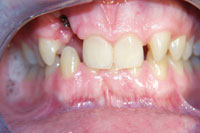Adult Orthodontics and a Post-Treatment Bonded Splint: A New Cosmetic Subspecialty
Originally posted on Dentistry.com
As the field of cosmetic dentistry is still rapidly evolving, we have not yet integrated the various specialties to provide seamless care in a case that requires multiple disciplines. For example, a patient needing orthodontics, crown and bridge or implants, gingival recontouring, orthodontic retention, and bonding will normally be cross-referred between their GP, periodontist, orthodontist, and perhaps an oral surgeon1,2 (4 doctors). While specialists normally provide the highest level of care, there exist certain cases where a “cosmetic subspecialist” may be best suited to create a final result that is harmonized in concept, proportion, and materials.
The following case would often be treated with orthodontics and retainers, and then relapse because of the unusual nature of the case and high tendency to relapse with removable retainers3 regardless of the duration of the orthodontics. The relapse in the anterior segment in adult patients is especially high.4 This patient had 3 missing anterior teeth as well as an impacted canine (Figure 1). Most orthodontists are not accustomed or trained to incorporate significant bonding and reshaping into their treatment plans, so the missing lateral incisors spaces would usually be opened up for implants or 6 units of crown and bridge to provide traditional canine guidance. Yet, there is insufficient bone for an implant for No. 7, and there are alternative treatment options that are simpler, far shorter in duration, and less expensive. Nontraditional thinking is required in this case, especially from an orthodontic perspective, as ideal treatment is most likely impossible.
CASE REPORT (FIGURE 1)
 |
 |
| Figure 1. Patient is missing 3 lateral incisors. Tooth No. 6 was fully impacted in bone before surgical exposure, and was used to substitute for the missing tooth No. 7 through extrusion, mesialization, reshaping, and bonding. | Figure 2. Bonding and reshaping was also done to the enamel and gingiva of the bicuspids to make them into canines. The front 6 teeth were splinted and bonded. This case has no implants or bridges. |
The patient had been to 3 orthodontists and was looking for treatment alternatives, as all 3 offered 2- to 3-year treatment plans with no promise of a satisfactory result because of bone issues surrounding tooth No. 6, among other things. The patient was not willing to crown all his anterior teeth, which had also been proposed. Our treatment plan involved surgical exposure and super-eruption of tooth No. 6, then making teeth Nos. 6 and 11 into lateral incisors through mesial movement and bonding, making teeth Nos. 5 and 12 into canines, minimizing the lower canine cusps, and connecting all anteriors with a Ribbond/composite splint for stability as well as to support the extra bonding that would be necessary (Figure 2).5
Instead of dividing the treatment by “specialty” and fragmenting the plan with 3 providers, in this way the case may be managed by one practitioner who is experienced in performing splinted retention with concurrent bonding. I previously wrote of a porcelain pontic veneer placed over a Ribbond splint used for orthodontics.6 This case shows how the splint can support significant bonding and provide needed fracture resistance to canines, which are made into laterals, and bicuspids which are made into canines. Equally important is the required fixation, as any relapse would reveal their deficient anatomy and ruin the “camouflage” effect of the bonding. Most orthodontic cases have some degree of relapse, and that would be unacceptable in cases such as this.
This treatment reflects a paradigm shift. Instead of providing a traditional orthodontic result by adding prosthetic lateral incisors, other teeth are moved shorter distances and bonded, providing a faster, simpler, and less expensive result. This is preferable for many patients who are more interested in avoiding gaping holes in their smile than committing to a 2-year treatment plan with endosseous implants. While patients are made aware of treatment alternatives, specifically what will not be provided in this plan, they overwhelmingly choose a method that resolves their chief aesthetic complaint. They are generally satisfied years at recall as well. Should they choose to crown or veneer this result in the future when more stability has been achieved, that option is still available to them.
CONCLUSION
Reshaping teeth via splinting and bonding is a practical, aesthetic alternative which addresses the high incidence of relapse still seen in orthodontics today. Simultaneously, this can serve to resolve some difficult and unusual aesthetic predicaments.
References
- Chadroff B. The interdisciplinary approach to implant dentistry. Gen Dent. 2004;52:321-326.
- Spear FM, Kokich VG, Mathews DP. Interdisciplinary management of anterior dental esthetics. J Am Dent Assoc. 2006;137:160-169.
- Hirschfelder U, Hertrich K. The treatment of deep bite in adults. Fortschr Kieferorthop. 1990;51:36-43.
- Lang G, Alfter G, Goz G, et al. Retention and stability—taking various treatment parameters into account. J Orofac Orthop. 2002;63:26-41.
- Kokich VO Jr, Kinzer GA. Managing congenitally missing lateral incisors. Part 1: Canine substitution. J Esthet Restor Dent. 2005;17:5-10.
- Georgaklis CC. Anterior retention with a reinforced composite resin splint after cosmetic orthodontic treatment. Dent Today. Jan 2002;21:54-57.

